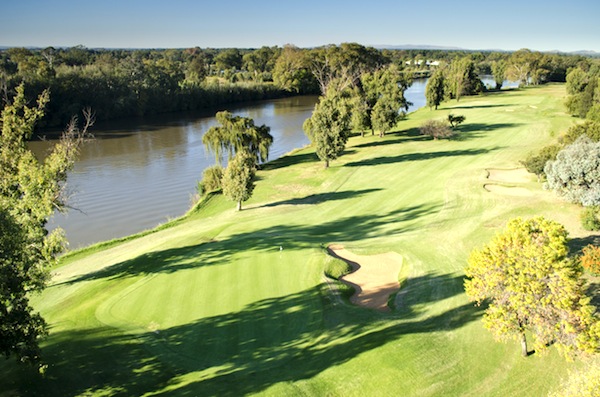Magnificent Maccauvlei
The history of Maccauvlei certainly makes for interesting reading. In the annals, the first mention of the area, on the south bank of the Vaal River, was when Voortrekker Carel Pistorius bought the farm from the Free State government in 1844. Pistorius, who had the quaint nickname of ‘Kwaai Angus’, also purchased a farm on the north bank of the river, but he made his home at Maccauvlei, where he farmed sheep.
The name ‘Maccauvlei’ was derived from the large wetland area inhabited by hippo and a variety of water fowl, including spur wing geese, known as ‘Wilde Maccaue’. It is said to have been a popular hunting spot, and a young Paul Kruger was one of the hunters who frequented the area that today forms part of the golf course. ‘Kwaai Angus’ would trek to Pietermaritzburg in his ox wagon to barter, and on one of these trips, he brought back acorns to plant in front of his veranda. These oaks would later play an important part in the Maccauvlei saga.
Maccauvlei Golf Club owes its existence to the famous industrialist and financier Sammy Marks, or at least Marks’ two sons Louis and Teddy. The Marks brothers had extensive business interests in the industrial hub of Vereeniging, and having been bitten by the golf bug while on holiday at the coast, they decided to establish a course of their own. It was obvious that this was not going to be just any old course, and they deployed their considerable resources to ensure that it would be something rather special.
But long before the idea to build the golf course was hatched, there had been another important development. In 1893, Sammy Marks employed a German horticulturist Otto Brandmuller to establish a forest on the banks of the Vaal. In one year alone, Brandmuller planted some 100 000 trees – the first from acorns taken from the oaks planted by Pistorius. Although one would hardly believe it today, Maccauvlei began its life as a links course and the land earmarked for the new layout was an expanse of sandy waste, broken by patches of reeds and rushes with stands of blue gums adjacent to the Vaal River. But over the years, as other trees were planted, it took on the character of a true parkland layout, and an unnecessarily well-made one at that.
The esteem in which Maccauvlei’s golf course was held soon after its opening in 1926 is proven by the fact that the club was deemed worthy of hosting the South African Open Championship – a mere 15 months after the layout was unveiled. (The club would host three more national championships after this.) The first patron of the new club was none other than the governor general of South Africa, and the list of members contained many of the heavyweight movers and shakers of the day. The layout was the work of Englishman George Peck (the man who designed East London’s magnificent course). Peck was an artist, landscape architect and keen golfer, and after routing and doing the major shaping of the course, the highly regarded Major SV Hotchkin was then called in to add certain finishing touches.
Hotchkin was in South Africa to design Humewood, and was commissioned by the Maccauvlei committee to extend his stay and offer his valuable input (for which he was paid the generous sum of 52 pounds and 10 shillings). The designers had the advantage of being unrestricted by boundaries, and could use whatever land they saw fit. They took full advantage of this licence, and by all accounts their efforts were nothing short of spectacular. One of the major changes made by Hotchkin was to convert the famous 17th from a par three to a dogleg two-shotter with a cavernous bunker. One of the talking points of this new course was its large greens – probably half the size they are today.
There can be no doubt that during the latter stages of the ‘roaring twenties’, and until the Second World War and beyond, Maccauvlei was considered to be if not the finest course in the country, certainly among the handful of truly premier layouts, and the membership swelled to 1 200. In the early 1930s, membership was closed and a waiting list was introduced. Amazingly, during these halcyon days, Maccauvlei was listed in the Guinness Book of Records as having the largest membership of any golf club in the world. The bulk of these members were from Johannesburg and its surrounding areas, and there was also a large contingent of foreign members.
The clubhouse and dormy houses are worthy of special mention, and were the work of one JH Dickinson, a prominent local businessman, contractor and the then major(?) of Vereeniging. The architect is unknown, but it seems the buildings were modelled on Dickinson’s own home, a copy of a Herbert Baker design. It is obvious that no expense was spared in providing all the creature comforts, and one rather interesting and unusual practice was that tot measures were not used in the bar – the bottle would be handed to the members and they would pour their own drinks in the style of the saloons of the ‘Wild West’.
The club was indeed a much-favoured weekend haunt for the Johannesburg elite, but in the early days, the road from the ‘Golden City’ left somewhat to be desired. Such was the status of the club (or more likely, the influence of the members) that SA Railways provided a special siding with a sign marked ‘Maccauvlei’ opposite the 4th fairway, so the well-heeled Johannesburg members could take a more comfortable train trip to their club. This station is sadly no longer there, but it was further immortalised by the radio programme on Springbok Radio – ‘Next stop Maccauvlei’.
Maccauvlei’s layout is simply a classic parkland that has all the attributes one would want from a members’ course – it is certainly no monster, nor is it a pushover, and playing at its full length, it is certainly capable of testing the best players in the game. Water comes into play on only four holes, but the hazards to be avoided here are the bunkers – all perfectly positioned – and the trees, which punish the errant shot.
This club has produced many fine players, not least of all Charl Schwartzel, who has made no secret of the fact that he loves this special club where he learned to play under the tutelage of his father George – also a fine player who is a past club captain of the club. During the 1990s, Peter Matkovich (who also makes no secret of the fact that this is one of his favourite courses) undertook the task of restoring parts of the course to its former glory. Like many old courses, changes over the years had caused the character of the layout to change, and with the help of old photographs found in the club’s archives, some features were tweaked.
This course is a fine example of a walkable, playable, mature beauty that has a wonderful collection of holes. It can no longer claim to have the huge membership it once did, and as more courses opened, particularly in the greater Johannesburg area, it was left to a smaller group of stalwarts to keep the club going – and we can be thankful they did. As dyed-in-the-wool golf clubs go, with a fascinating history and a warm atmosphere, it doesn’t get much better than this. The short drive from Johannesburg to play this gem is well worth the effort, and the modest greenfee represents excellent value for money.
Getting there: From the N12 heading south, follow the signs for the R59 towards Vereeniging. Take exit 402 to merge into Sybrand van Niekerk freeway/R59 towards Vereeniging. Take exit 8 onto the R82/Johannesburg Road towards Vereeniging/Voortrekker Street. Continue to follow the R82. Turn left into Victoria Avenue, and left into Mario Milani Drive. The club is on the right.
Course: Classic parkland, par 72, 6 980 metres.
Designers: George Peck (1926), Major SV Hotchkin, Peter Matkovich (restoration).
General manager: Leon Kruger
Resident professional: Marthinus van Staden
Club captain: Ben Botes
Course superintendent: Steven Motitsoe
Club champion: Karabo Mokoena
Course record: 59 – Bradford Vaughan
Visitor greenfees: Peak: R235, Off-peak: R170
Contact: Tel: 016 421 3196
Email: [email protected]
Website: www.maccauvleigolfclub.co.za
LIKES
This is a genuine, old-style golf course with an interesting history and without gimmicks.
The atmosphere is tranquil and the locals friendly.
The greenfees are a real bargain for a course of this quality.
DISLIKES
It’s a little out of the way, but worth the trip.
The clubhouse decor doesn’t quite do justice to the history of the club.







